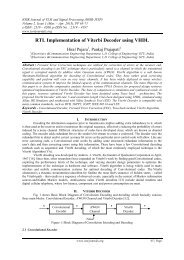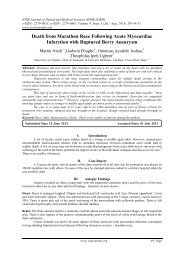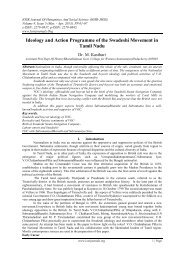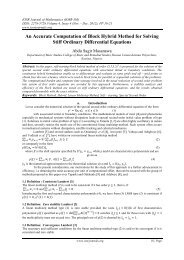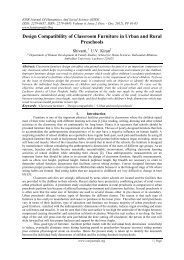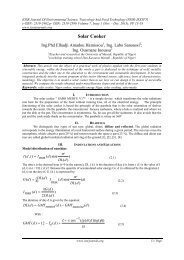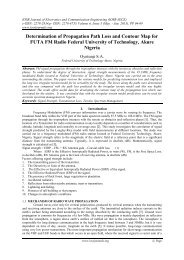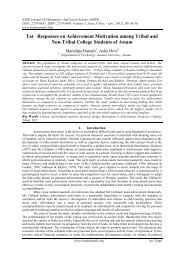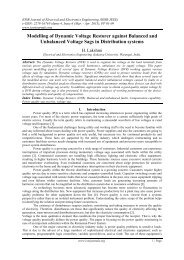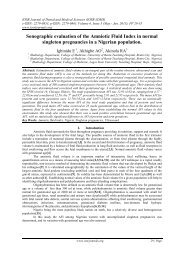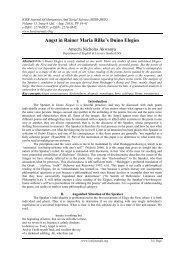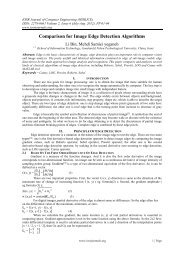Full PDF - IOSR
Full PDF - IOSR
Full PDF - IOSR
Create successful ePaper yourself
Turn your PDF publications into a flip-book with our unique Google optimized e-Paper software.
Behaviour of Eccentrically Loaded Model Square Footing on Reinforced Soil: An Experimental Investigation<br />
This helps in creating the desired roughness in the rubber grid and in turn develops greater frictional<br />
resistance, although its tensile strength is less than that of geo grid. Semi- elastic properties of rubber grid<br />
develop better pseudo- cohesion owing to the temporary deformation of rubber grid. However, this mechanism<br />
is not present in case of other conventional grids. Moreover, the apertures present in the grid structure, there are<br />
chances for better interlocking of the sub-grade and the reinforcement along with the backfill material. Hence,<br />
the performance of grids is better than that of geo-textile.<br />
V. SUMMARY AND CONCLUSIONS<br />
Some of the broad conclusions emerged from the present study are as under:<br />
i. Provision of reinforcement results in enhancement of ultimate bearing pressure and bearing capacity<br />
ratio (BCR). This enhancement is more for higher load eccentricities as compared to the lower ones,<br />
thus showing beneficial effects of the reinforcement.<br />
ii. Reduction in settlement on provision of reinforcement, shows a decreasing trend, i.e., settlements are<br />
more at higher load eccentricities.<br />
iii. Performance of rubber grid is superior to the other two reinforcements, both in terms of bearing<br />
capacity ratio (BCR) and settlement reduction, with geotextile being the least effective.<br />
iv. Optimum width of reinforcement (B’) for deriving maximum possible BCR is about 4B in case of all<br />
the reinforcements and for both the footings.<br />
v. With geo-synthetic reinforcement, the critical value of H/B ratio corresponding to maximum BCR is<br />
about 0.375 for all reinforcing elements.<br />
vi. Rubber reinforcement probes to be more economical and effective soil reinforcing elements.<br />
The performance of eccentrically loaded model square footing improves with the presence of<br />
reinforcing element in the soil system. This is reflected in terms of the values of BCR, SRF and tilt of footing.<br />
The beneficial effect of reinforcement is particularly observed at higher load eccentricities as shown by the<br />
increasing values of BCR. The better performance of rubber grid could be a cheaper and viable alternative for<br />
effective ground improvement. The study underscores the effective utilization of the solid wastes generated in<br />
the process of mining in conjunction with the rubber wastes as civil engineering construction materials.<br />
REFERENCES<br />
[1] Mayerhof, G.G., “The Ultimate Bearing Capacity of Foundations on Slopes”, Proc. 4 th International Conference on Soil<br />
Mechanics and Foundation Engineering, 1, 1957, 384-386.<br />
[2] Siddiquee, M.S.A., Tatsuoka, F. and Tanaka, T, “Model Tests and FEM Simulation of Some Factors affecting Bearing Capacity<br />
of a Footing on Sand”, Soils and Foundation, 4(2) . 2001,53-76.<br />
[3] Ingold, T.S., “Some Observations on the Laboratory Measurement of Soil Geotextile Bond”, Geotechnical Testing Journal,<br />
ASTM, 5 (3), 1982, 57-67.<br />
[4] Kate, J.M., Rao, G.V., and Tyagi, S.K., “Evaluation of Soil Reinforcement Friction”, Indian Geotechnical Journal, 18 (2), 1988,<br />
153-160.<br />
[5] Binquet, J. and Lee, K.H., “Bearing Capacity Analysis of Reinforced earth Slab”, Journal of Getechnical Engineering, ASCE,<br />
101, 1975,1251-1276.<br />
[6] Akinmusru, J. O. and Akinbolade, J.A., “Stability of Loaded Footings on Reinforced Soil”, Journal of Geotechnical Engineering,<br />
ASCE, 107 (GT-6), 1981,819-827.<br />
[7] Ohri, M.L. and Choudhari, G.R., “Pressure- Settlement Behaviour of Reinforced Dune Sand”, Proc. Indian Geotechnical<br />
Conference, Surat, 1991, 335-358.<br />
[8] Manjunath, V.R, “Stress Deformation Behaviour and Bearing Capacity of Geofabric Reinforced Soils”, Ph.D. Thesis Submitted<br />
to IIT Bombay (Unpublished), 1995.<br />
[9] Dash, S.K., Krishnaswamy, N.R., and Rajgopal, K., “Bearing Capacity of Strip Footings Supported on Geocell Reinforced<br />
Sand”, Geotextiles and Geomembranes, 19 (4), 2001, 235-256.<br />
[10] Kumar, A. and Saran, S., “Closely Spaced Footings on Geo-grid Reinforced Sand”, Journal of Geotechnical and Geoenvironmental<br />
Engineering, ASCE, 129 (7), 2003, 660-664.<br />
[11] Basudhar, P.K., Saha, S. and Deb, K., “Circular Footings resting on Geotextile Reinforced Sand Bed”, Geotextiles and<br />
Geomembranes, 25 (6), 2007, 377-386.<br />
[12] Benson, C. and Khire, M., “Soil Reinforcement with Strips of Reclaimed HDPE”, Journal of Geotechnical Engineering, ASCE,<br />
120 (5), 1994, 838-855.<br />
[13] Garga, V.K. and O’ Shuaghnessy, V., “Tyre Reinforced Earth Fill –I, II and III”, Canadian Geotechnical Journal, Vol. 37, 2000,<br />
75-131<br />
[14] Kumar, P., Mehndiratta, H.C. and Durga Rao, A.K., “Use of Polythene in Fly Ash Soil Embankments”, Proceedings National<br />
Symposium on Advances in Geotechnical Engineering, IISc Banglore, 2004, 279-284<br />
[15] Dewaikar, D.M., Guptha, K.G. and Chore, H.S., “Use of Tyre wastes into an Experimental Study of Model Footings on<br />
Reinforced Soil”, Journal of Structural Engineering, 38 (1), 2011, 84-93<br />
Second International Conference on Emerging Trends in Engineering (SICETE)<br />
Dr.J.J.Magdum College of Engineering, Jaysingpur<br />
58 | Page



